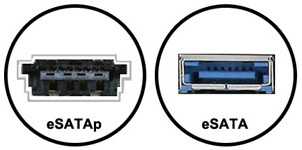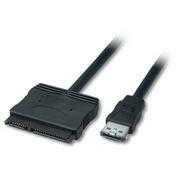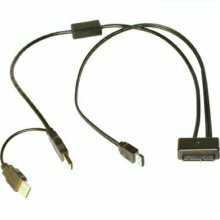The original eSATA specification does not provide power. You'll need a USB cable or wall adapter to power the hard drive. The new eSATAp specification utilizes the USB bus to provide power over one cable, but is relatively rare.
The easiest way to be sure if you have an eSATAp device or not is to check the plug. This helpful image from Wikipedia shows the difference:

Here is a eSATAp to SATA+SATA Power so that any standard SATA drive can utilize the power from the eSATAp connection without the need of a USB connection, and only requires the eSATAp connection on the computer end:

They also make cables that convert the standard SATA data/power connections to eSATA for data and USB for power:

However, a far better option IMHO is to buy an external drive enclosure, which is essentially a box you insert your hard drive into with cables provided for USB power and eSATA data. The enclosure will protect your bare drive from damage, and as far as I can tell, aren't that much more expensive than regular cables.



Thanks for your answer, though I'm not sure if I got the eSATAp or the eSATA. It's look like I got the powered one. How can I be sure of this? and eSATAp require special cable as well? – Matan Eldan – 2011-04-05T08:36:47.270
@Matan: I'm afraid that won't do. I added information about your specific requirements to my answer. – Patches – 2011-04-05T09:20:31.743
1Thank you very much for your help! It seems that I got this eSATAp, and that I only need this cable. I'll try that option first. Thanks again – Matan Eldan – 2011-04-05T09:25:34.930
2A few notes: an eSATAp port is a combination of eSATA and USB. That means any USB device plug will fit and work normally in it. Also note that eSATA ports on desktop PCs are usually unpowered. Laptops have eSATAp ports with the usual USB 5V voltage. There is also a third standard that adds 12V and can so power 3.5 inch drives – David Balažic – 2013-11-08T22:09:38.653